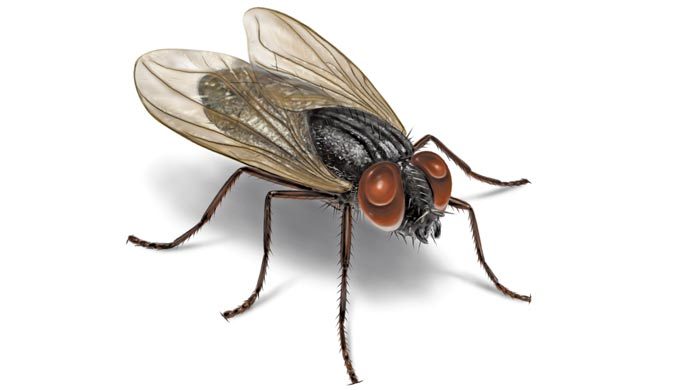
By Hope Bowman, Technical Specialist, Western Pest Services
Fun Fact: flies are twice as filthy as cockroaches and carry more disease-causing pathogens.
Flies feed on organic waste, thus they collect numerous pathogens on their legs and mouths. This means, each time one of these flying pests land, they slough off thousands of microbes and bacteria that can contaminate food and surfaces. These filthy pests not only pose a health risk to your restaurant patrons, but they can undermine your reputation and pose an even bigger risk to your bottom line.
Keep Customers from Dropping Like Flies
A spotless kitchen is key to maintaining a spotless reputation and reviews. However, to avoid a fly infestation, proactive pest management is a crucial component to keeping your restaurant’s reputation and customers in upstanding shape. This is because each time a fly lands it can spread germs that can cause illnesses such as diarrhea, food poisoning, meningitis and bloodstream infections. Flies can move quickly from potentially contaminated garbage to exposed human foods and utensils.
There are more than 200 species of flies in North America that are considered “filth” flies. They utilize a human’s environment to thrive. Restaurants are particularly susceptible to these pests because flies seek the food, water and shelter that these establishments possess. Flies can not only disgust your customers and contaminate food, but they can also cause health inspection violations.
Time Flies When You’re… Identifying Your Pest
They speed through the air quickly, and believe it or not, they can breed even faster. Some species of female flies lay up 1,000 eggs in their lives. There are many types of flies that each bring their own set of challenges to restaurant establishments.
One of the most common types of flies found in restaurants is a house fly. They are also referred to as a garbage fly. Their egg-laying sites typically involve organic material, like food, which is abundant in restaurant establishments. They can most easily be identified with four lengthwise stripes on the thorax. They spread microorganisms such as bacteria and viruses on surfaces they land and are associated with more than 100 pathogens, including Salmonella, Staphylococcus, E. coli and Shigella.
Fruit flies (or vinegar flies) are regularly found in restaurants. On the smaller size, these eighth-inch long pests lay their eggs near fruits and vegetables (and other decaying matter). You can find them near fermented materials in trashcans and floor drains.
Phorid flies, another common type of restaurant fly, have humped backs, which makes them easy to recognize. They are about a ¼-inch long and thrive off moisture and breed in decaying matter so they can often be found in the bottom of trash cans, kitchen equipment and backed up drains.
And lastly, sewer flies (also known as drain flies) are common restaurant invaders. These have small, furry bodies and hairy wings. They can live up to a month, while surviving dramatic changes in temperature and low-oxygen environments. Sewer flies breed in raw sewage under slabs where undetected broken pipes may be located, as they need standing water to breed.
Now that you know the types, below are a few of the hot spots where you may find these pests:
- Food prep areas
- Storage areas
- Trashcans, drains and dumpsters
- Loading and receiving docks
- Incoming shipments
- Building exterior
- Plants, foliage, and any areas with decaying organic matter, like food
Pass (a health inspection) with Flying Colors
When it comes to health inspections, the main purpose is food safety. Pests that can contaminate food and surfaces can cause health inspection point deductions. In extreme situations, an active infestation can cause an establishment to be shut down immediately. A clean kitchen isn’t enough to prevent a fly infestation. Here are some of the elements that should be part of your recipe for successful fly control:
- Inspect. Be sure to inspect all shipments and supplies upon receipt and before storing.
- Exclude. Every building has cracks, gaps and holes in doors, windows and walls. Seal these with caulk or weather stripping. An HVAC professional can help ensure proper air flow with proper pest exclusion.
- Sanitize. Organic material, like food and waste, is a huge draw for flies. Use cleaning products that decompose organic materials from drains and high-trafficked surfaces. Also, be sure to move dumpsters as far away from your building as possible, as flies thrive in warm, moist conditions–sites like this are where they seek to reproduce.
- Light Smart. Not only are they food contaminators and disease spreaders, but they also are attracted to certain wavelengths of light. Installing insect light traps (ILTs) can draw flies to a non-toxic sticky board. These ILTs use ultraviolet light bulbs to attract the pets.
- Inspect. A pest management professional can help to identify the source of a fly infestation, which is key to proper prevention.
- Educate. Employees can be the first line of defense against a fly infestation. Be sure all employees are informed about the dangers of flies, and know to proactively report any fly incidences as they occur.
With these tips and some help from your pest management professional, you can create a no-fly zone in your establishment.
Western understands that no two food service establishments are exactly the same. We customize our fly control strategies for each organization starting with a comprehensive, on-site inspection. Effective pest management is a process, not a one-time event. With our Integrated Pest Management (IPM) approach, we can help you stay a step ahead of pest management so you are prepared for your next health inspection.
Hope Bowman is a Technical Specialist and Board-Certified Entomologist with Western Pest Services, a New Jersey-based pest management company serving businesses and homeowners in major Northeastern markets. Learn more about Western by visiting www.westernpest.com.























